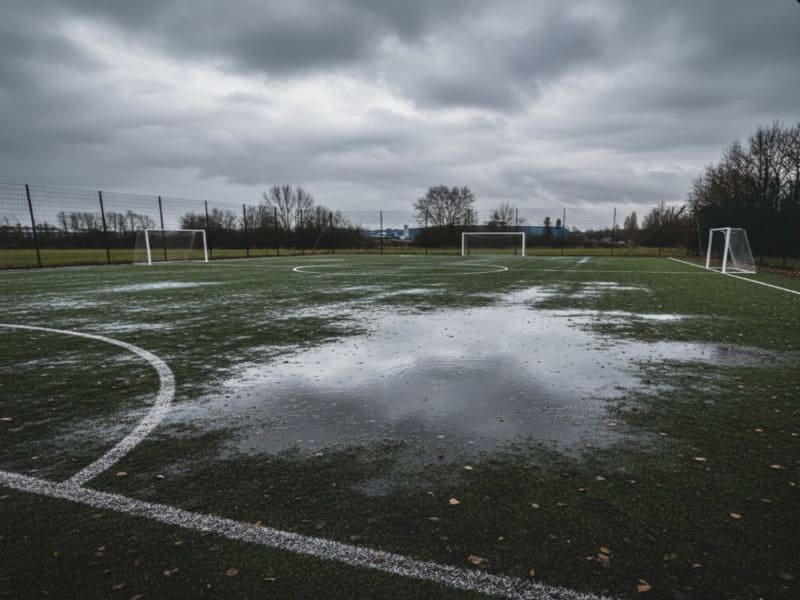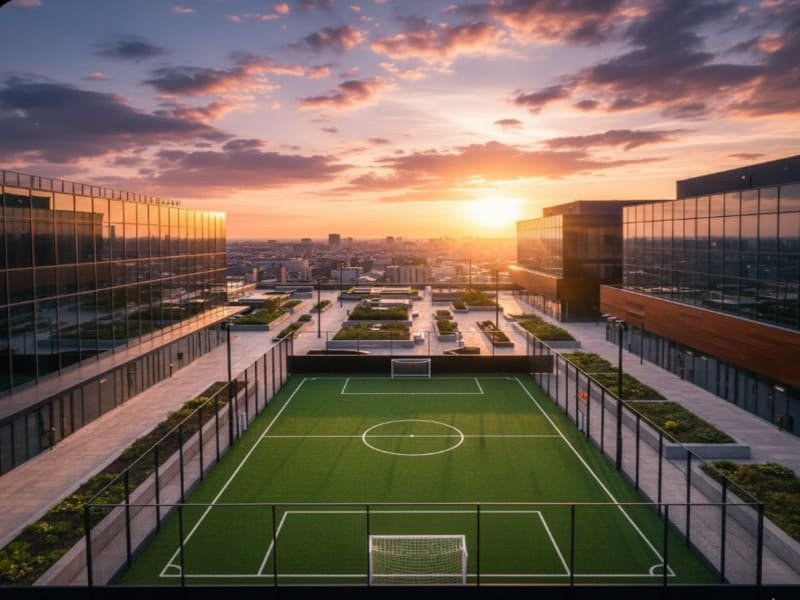The Total Cost of Ownership (TCO) for a 5v5 synthetic pitch is calculated by summing the initial Capital Expenditure (CAPEX), the long-term Operational Expenditure (OPEX), and the future Replacement Cost, then subtracting the total revenue generated over its lifespan. This approach reveals the true, net investment.
The Strategic Investment: Why TCO Matters
I have been in this industry for a long time. I know many facility managers focus only on the initial quote. That quote is just the start. You need to see the whole financial picture. The initial cost for a high-quality 5v5 synthetic turf pitch is more than natural grass. But, the long-term savings and increased revenue quickly make it the better choice. We help you use critical thinking to break down the problem. This helps you understand the true value of synthetic turf. It is a long-term asset, not just a one-time purchase.
The cost analysis must include all phases: Planning, purchase, installation, maintenance, and end-of-life replacement. Ignoring the operational costs means you will face financial surprises later. A full TCO view lets you set better budgets and get funding approval. This approach moves the discussion from a simple price comparison to a smart business investment. My experience shows that a well-chosen turf system gives a better Return on Investment (ROI) over ten years than any natural grass field.

The Investment Imperative: Is Synthetic Turf Really a Cost-Saver?
We need to look past the upfront price.
Does Synthetic Turf Offer Better Financial Returns Than Natural Grass?
Yes, synthetic turf offers better financial returns because of lower maintenance costs and higher field utilization. Natural grass requires constant watering, mowing, seeding, and rest time. Synthetic turf requires less time and money for upkeep, allowing for near 24/7 use and more revenue generation.
Step-by-Step: How to Calculate TCO for Your 5v5 Pitch
My role is to give you concrete numbers. The formula for TCO must be clear. This allows for direct comparison with other investments. We use the field size of 1,000 m² (a common size for a 5v5 setup) for this example.
What are the Key Components of the Total Cost of Ownership (TCO)?
TCO = (CAPEX Initial + ∑ OPEX Annual × Years + CAPEX Replacement) – ∑ Revenue Annual × Years
| Component | Example Cost (10-Year Period) | Notes (Estimated Costs) |
|---|---|---|
| A. Initial CAPEX | $75,000 | Includes turf, infill, base construction, shock pad (approx. $75/m²). |
| B. Annual OPEX | $2,000/year × 10 years = $20,000 | Maintenance, infill top-up, minimal utilities (approx. $2/m² per year). |
| C. Replacement CAPEX | $25,000 | Estimated cost to remove old turf and install new after 10 years. |
| D. Total Revenue | $10,000/year × 10 years = $100,000 | Based on conservative usage (see revenue section). |
| Total TCO (Net Investment) | $20,000 | (75,000 + 20,000 + 25,000) – 100,000 |
The net investment over 10 years is just $20,000 in this case. This shows the pitch pays for itself through operation. The average cost for a high-quality 5v5 pitch (turf and shock pad included) is about USD 60–90 per square meter. This knowledge helps you budget correctly.

Investment Strategy and Long-Term Growth
We must talk about money and growth. The high utilization is the core of your ROI.
How Can a 5v5 Pitch Maximize Utilization and Revenue?
A synthetic 5v5 pitch maximizes revenue by allowing 24/7 use in almost all weather conditions, unlike natural grass. This higher utilization rate means the facility can schedule more events, training sessions, and rentals, resulting in higher returns on the initial capital investment.
Maximizing Utilization and Revenue Potential
Synthetic turf is ready to play, always. This increases your capacity to generate income. This is a critical factor for club owners.
- Example Revenue Calculation:
If your pitch rents for $100 per hour (a reasonable rate depending on location).
It operates 6 hours per day (a conservative average for evening/weekend usage).
It operates 25 days per month (accounting for quiet days).
Monthly Revenue Potential: $100 × 6 hours × 25 days = $15,000.
A high-quality pitch investment of, for example, $90,000 can often be recovered in gross revenue within 8 to 12 months of full operation. This rapid ROI is a strong business case. We offer solutions that enable multi-sport use. This further diversifies your income streams.
Detailed Operational Expenditure (OPEX) and Maintenance Cycles
The annual OPEX for a synthetic field is low, about USD 2–3 per square meter. This is a huge saving over natural grass. But you must stick to a schedule. Ignoring maintenance shortens the life of the turf.
| Maintenance Task | Frequency | Estimated Annual Cost | Why It Matters (E-E-A-T Focus) |
|---|---|---|---|
| Brushing | Weekly | $300 | Redistributes infill, keeps fibers upright, ensures consistent ball roll. |
| Infill Top-up | Every 2–3 years | $1,500 | Maintains the critical shock absorption layer for player safety (HIC standards). |
| Deep Cleaning | Every 6 months | $500 | Removes organic material and debris, prevents algae/mold growth. |
| Seam Inspection | Every 6 months | $0 (in-house labor) | Prevents seam separation, which is a major trip hazard and liability risk. |
| Shock Pad Inspection | Every 5 years | $0 (part of my team’s service) | Confirms the elastic layer maintains vertical deformation compliance. |
This clear schedule enhances the durability and longevity of the pitch. My experience shows that planned, low-cost maintenance avoids expensive, high-cost repairs.

Mitigating Risk and Ensuring Compliance
We must address safety. This is a top concern for everyone.
How Does Turf Quality Reduce Liability and Ensure Safety Compliance?
High-quality turf reduces liability by providing certified shock absorption, minimizing the risk of serious injuries like concussions and joint stress. Compliance is ensured by adhering to international standards like FIFA Quality, which mandates strict testing for shock absorption, vertical deformation, and ball behavior.
Safety, Health, and Liability
My team always says: Safety first, then performance. We use specific materials and engineering methods to achieve top safety ratings. The installation of the shock pad is as important as the turf itself. It gives the soft feel for the player. This feel is like playing on natural grass. This design lessens stress on players’ joints and muscles. We use certified, non-toxic infill materials. This takes away any health worries for school procurement officers. A strong warranty gives a clear safety net. It confirms the vendor is responsible for the quality of their product for the full warranty period. This is the trust element.
Cultivating Talent and Community Engagement
The pitch is for the community.
How Does a New Pitch Support Community Programs and Talent Development?
A high-quality 5v5 pitch supports program development by offering a reliable, safe surface for continuous training, regardless of weather. This stability helps youth program directors build consistent training schedules, leading to better talent development and higher community participation rates.
Frequently Asked Questions
Q1: How long does a 5v5 synthetic turf last?
A1: 10 to 15 years is the typical lifespan. This depends heavily on the use intensity (hours per week) and the quality of the infill and fiber used.
Q2: What’s the most expensive part of the installation?
A2: The base construction and shock pad are the highest costs. Together, they can represent 40% of the total Initial CAPEX. A poor base leads to expensive, long-term problems.
Q3: Can I get government grants or sponsorships for community fields?
A3: Yes. In many regions, local councils offer sports development funding for synthetic turf projects. You must structure your investment plan, including the TCO, to match their funding criteria.
Q4: What is the biggest mistake facility owners make with turf?
A4: Neglecting the weekly infill brushing. This allows the infill to migrate, leading to uneven surface hardness and faster fiber wear, greatly reducing the turf’s lifespan.
Conclusion
The TCO analysis shows that a 5v5 synthetic pitch is a smart, strategic investment. It gives high performance, low risk, and maximum revenue.
Next Step
Would you like us to provide a customized 10-year TCO analysis for your specific facility and a free sample of our FIFA-certified turf? Contact my team today to start your free project consultation and receive a precise TCO projection.

